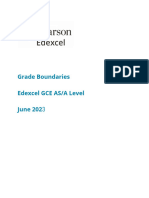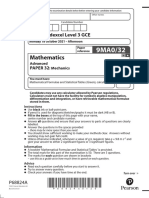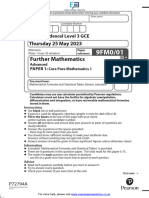2024 Edexcel A Level Predicted Paper 3 Version 1
Uploaded by
josephkrolick92024 Edexcel A Level Predicted Paper 3 Version 1
Uploaded by
josephkrolick9DISCLAIMER:
THERE IS NO GUARANTEE THESE TOPICS WILL COME UP ON
PAPER 3! USE THIS PAPER AS PRACTICE ON TOP OF THOROUGH
REVISION - VARIATION IS KEY TO SUCCESS!
WARNING:
I HAVE MADE THIS PAPER CHALLENGING!
VIDEO LIVE SESSIONS SUPPORT
SOLUTIONS AND MORE MR ASTBURY
I HAVE SELECTED 1 QUESTION FROM EACH OF THE MAJOR
TOPICS LISTED BELOW.
Stats Mechanics
1. Correlation 8. Velocity-time graphs
2. Measures of Central Tendency 9. Constant Acceleration/Vectors
3. Probability 10. Variable Acceleration/Vectors
4. Discrete Distributions 11. Projectiles
5. Binomial & Hypothesis Tests 12. Dynamics
6. Normal & Hypothesis Tests 13. Connected Particles
7. Normal Approximation 14. Moments
N.B. There are other topics that have not made this list. To name a
few: large data set, sampling, outliers, cumulative frequency,
histograms, tree diagrams, modelling, displacement-time graphs,
constant and variable acceleration without vectors.
14 Questions – 154 Marks
1. Correlation
(Total for question = 9 marks)
2. Measures of Central Tendency
Gill buys a bag of logs to use in her stove. The lengths, l cm, of the 88 logs in the bag are summarised in
the table below.
A histogram is drawn to represent these data.
The bar representing logs with length has a width of 1.5 cm and a height of 4 cm.
(a) Calculate the width and height of the bar representing log lengths of
(3)
(b) Use linear interpolation to estimate the median of l
(2)
The maximum length of log Gill can use in her stove is 26 cm.
Gill estimates, using linear interpolation, that x logs from the bag will fit into her stove.
(c) Show that x = 62
(1)
Gill randomly selects 4 logs from the bag.
(d) Using x = 62 , find the probability that all 4 logs will fit into her stove.
(2)
The weights, W grams, of the logs in the bag are coded using y = 0.5w - 255 and summarised by
n = 88 ∑ y = 924 ∑ y2 = 12 862
(e) Calculate
(i) the mean of W
(3)
(ii) the variance of W
(3)
(Total for question = 14 marks)
3. Probability
The Venn diagram shows the events A, B, C and D, where p, q, r and s are probabilities.
(a) Write down the value of
(i) P(A)
(ii) P(AΙB)
(iii) P(AΙC)
(3)
(b) find the exact value of q and the exact value of r
(6)
(c) find the exact value of s
(2)
(Total for question = 11 marks)
4. Discrete Distributions
(Total for question = 10 marks)
5. Binomial & Hypothesis Tests
Superbounce is a manufacturer of tennis balls.
It knows from past records that 10% of its tennis balls fail a bounce test.
(a) Find the probability that from a random sample of 10 of these tennis balls
(i) at least 4 fail the bounce test
(ii) more than 1 but fewer than 5 fail the bounce test.
(4)
The managing director makes changes to the production process and claims that these changes will
reduce the probability of its tennis balls failing the bounce test.
After the changes were made a random sample of 50 of the tennis balls were tested and it was found that 2
failed the bounce test.
(b) Test, at the 5% significance level, whether or not this result supports the managing director's claim.
(4)
In a second random sample of n tennis balls it was found that none failed the bounce test. As a result of
this sample, the managing director's claim is supported at the 1% significance level.
(c) Find the smallest possible value of n
(3)
(Total for question = 11 marks)
6. Normal & Hypothesis Tests
(Total for question = 13 marks)
7. Normal Approximation
The probability that a person completes a particular task in less than 15 minutes is 0.4
Jeffrey selects 20 people at random and asks them to complete the task. The random variable, X,
represents the number of people who complete the task in less than 15 minutes.
(a) Find P(5 ≤ X< 8)
(3)
Mia takes a random sample of 140 people.
Using a normal approximation, the probability that fewer than n of these 140 people complete the task in
less than 15 minutes is 0.0239 to 4 decimal places.
(b) Find the value of n
Show your working clearly.
(6)
(Total for question = 9 marks)
8. Velocity-time graphs
Two small children, Ajaz and Beth, are running a 100 m race along a straight horizontal track.
They both start from rest, leaving the start line at the same time.
Ajaz accelerates at 0.8 m s–2 up to a speed of 4 m s–1 and then maintains this speed until he crosses the
finish line.
Beth accelerates at 1 m s–2 for T seconds and then maintains a constant speed until she crosses the finish
line.
Ajaz and Beth cross the finish line at the same time.
(a) Sketch, on the same axes, a speed-time graph for each child, from the instant when they leave the start
line to the instant when they cross the finish line.
(3)
(b) Find the time taken by Ajaz to complete the race.
(4)
(c) Find the value of T
(4)
(d) Find the difference in the speeds of the two children as they cross the finish line.
(2)
(Total for question = 13 marks)
9. Constant Acceleration/Vectors
(Total for question = 12 marks)
10. Variable Acceleration/Vectors
A particle P of mass 1.5 kg moves under the action of a single force F newtons.
At time t seconds, t ≥ 0, P has velocity v ms–1, where
v = (5t2 – t3)i + (2t3 – 8t)j
(a) Find F when t = 2
(4)
At time t = 0, P is at the origin O.
(b) Find the position vector of P relative to O at the instant when P is moving in the direction of the vector j
(4)
(Total for question = 8 marks)
11. Projectiles
A small ball is projected with velocity (6i + 12j) ms–1 from a fixed point A on horizontal ground. The ball hits
the ground at the point B, as shown in Figure 5. The motion of the ball is modelled as a particle moving
freely under gravity.
(a) Find the distance AB.
(4)
When the height of the ball above the ground is more than h metres, the speed of the ball is less than 10
ms–1
(b) Find the smallest possible value of h.
(4)
(Total for question = 8 marks)
12. Dynamics
A rough plane is inclined to the horizontal at an angle α, where tan α = 3/4
A particle P of mass 2 kg is held in equilibrium on the plane by a horizontal force of magnitude X newtons,
as shown in Figure 2. The force acts in a vertical plane which contains a line of greatest slope of the
inclined plane.
(a) Show that when X = 14.7 there is no frictional force acting on P
(3)
The coefficient of friction between P and the plane is 0.5
(b) Find the smallest possible value of X.
(8)
(Total for question = 11 marks)
13. Connected Particles
One end of a light inextensible string is attached to a particle A of mass 2m. The other end of the string is
attached to a particle B of mass 3m. The string passes over a small, smooth, light pulley P which is fixed at
the top of a rough inclined plane. The plane is inclined to the horizontal at an angle α, where tan α = 3/4
Particle A is held at rest on the plane with the string taut and B hanging freely below P, as shown in Figure
4. The section of the string AP is parallel to a line of greatest slope of the plane.
The coefficient of friction between A and the plane is 1/2
Particle A is released and begins to move up the plane.
For the motion before A reaches the pulley,
(a) (i) write down an equation of motion for A,
(ii) write down an equation of motion for B,
(4)
(b) find, in terms of g, the acceleration of A,
(5)
(c) find the magnitude of the force exerted on the pulley by the string.
(4)
(d) State how you have used the information that P is a smooth pulley.
(1)
(Total for question = 14 marks)
14. Moments
A ladder AB has length 6 m and mass 30 kg. The ladder rests in equilibrium at 60° to the horizontal with the
end A on rough horizontal ground and the end B against a smooth vertical wall, as shown in Figure 3.
A man of mass 70 kg stands on the ladder at the point C, where AC = 2 m, and the ladder remains in
equilibrium. The ladder is modelled as a uniform rod in a vertical plane perpendicular to the wall. The man
is modelled as a particle.
(a) Find the magnitude of the force exerted on the ladder by the ground.
(6)
The man climbs further up the ladder. When he is at the point D on the ladder, the ladder is about to slip.
Given that the coefficient of friction between the ladder and the ground is 0.4
(b) find the distance AD.
(4)
(c) State how you have used the modelling assumption that the ladder is a rod.
(1)
(Total for question = 11 marks)
If you found this paper useful, please consider supporting the channel.
Thank you!
YOUTUBE LIVE SESSIONS SUPPORT
CHANNEL AND MORE MR ASTBURY
You might also like
- Instant Download 5 Steps to a 5: AP Statistics 2024 1st Edition Jared Derksen PDF All Chapters100% (6)Instant Download 5 Steps to a 5: AP Statistics 2024 1st Edition Jared Derksen PDF All Chapters66 pages
- 02 9MA0 01 9MA0 02 A Level Pure Mathematics Practice Set 2 Mark Scheme 1100% (1)02 9MA0 01 9MA0 02 A Level Pure Mathematics Practice Set 2 Mark Scheme 119 pages
- 2206 8MA0-21 As Statistics June 2022 Shadow Paper WordNo ratings yet2206 8MA0-21 As Statistics June 2022 Shadow Paper Word5 pages
- Mock Set 1 Mathematics A Level Paper 32 Mechanics Mark SchemeNo ratings yetMock Set 1 Mathematics A Level Paper 32 Mechanics Mark Scheme13 pages
- 2024 Edexcel A Level Predicted Paper 3 Version 1No ratings yet2024 Edexcel A Level Predicted Paper 3 Version 117 pages
- 9FM0 Topic Test - CP - 13 - Hyperbolic Functions MS PDFNo ratings yet9FM0 Topic Test - CP - 13 - Hyperbolic Functions MS PDF13 pages
- AQA A Level Geography RAG Checklist - Paper 1 CombinedNo ratings yetAQA A Level Geography RAG Checklist - Paper 1 Combined7 pages
- 01b As Further Core Maths 8fm0 01 Paper Mark SchemeNo ratings yet01b As Further Core Maths 8fm0 01 Paper Mark Scheme13 pages
- Gordon A. Fenton, D. v. Griffithsauth. Risk Assessment in Geotechnical Engineering100% (2)Gordon A. Fenton, D. v. Griffithsauth. Risk Assessment in Geotechnical Engineering463 pages
- Sample Assessment Materials Model Answers-Pure For As and A Level Mathematics0% (3)Sample Assessment Materials Model Answers-Pure For As and A Level Mathematics87 pages
- 12 AS Statistics and Mechanics Practice Paper F Mark SchemeNo ratings yet12 AS Statistics and Mechanics Practice Paper F Mark Scheme9 pages
- Mechanics IAL Edexcel Kinematics Topical QuestionsNo ratings yetMechanics IAL Edexcel Kinematics Topical Questions22 pages
- A Level Core Pure Mathematics 1 June 2023 PDF MSNo ratings yetA Level Core Pure Mathematics 1 June 2023 PDF MS30 pages
- Further Mathematics: Pearson Edexcel Level 3 GCENo ratings yetFurther Mathematics: Pearson Edexcel Level 3 GCE36 pages
- Edexcel GCE: 6674 Pure Mathematics P4 Advanced/Advanced SubsidiaryNo ratings yetEdexcel GCE: 6674 Pure Mathematics P4 Advanced/Advanced Subsidiary4 pages
- Toby Cooper - Philip Lynch - Eric Magee - Paul Fairclough - UK Government and Politics. A-Level. (2022) - Libgen - Li100% (1)Toby Cooper - Philip Lynch - Eric Magee - Paul Fairclough - UK Government and Politics. A-Level. (2022) - Libgen - Li396 pages
- 8MA0-01 AS Pure Mathematics May 2019 PDFNo ratings yet8MA0-01 AS Pure Mathematics May 2019 PDF44 pages
- Further Mathematics: Thursday 25 May 2023No ratings yetFurther Mathematics: Thursday 25 May 202328 pages
- EdExcel A Level Chemistry Unit 4 Mark Scheme Results Paper 1 June 2007No ratings yetEdExcel A Level Chemistry Unit 4 Mark Scheme Results Paper 1 June 200721 pages
- IAL Edexcel Pure Mathematics 1 Jan 20 Mark SchemeNo ratings yetIAL Edexcel Pure Mathematics 1 Jan 20 Mark Scheme26 pages
- 8MA0-21 as Statistics - Mock Set 1 Mark Scheme (PDF)No ratings yet8MA0-21 as Statistics - Mock Set 1 Mark Scheme (PDF)9 pages
- AS Statistics and Mechanics Paper I Mark SchemeNo ratings yetAS Statistics and Mechanics Paper I Mark Scheme8 pages
- 17 AS Statistics and Mechanics Practice Paper INo ratings yet17 AS Statistics and Mechanics Practice Paper I6 pages
- Applied Statistics For Economic and BuisnessNo ratings yetApplied Statistics For Economic and Buisness315 pages
- Chapter 5 Discrete Probability Distributions0% (1)Chapter 5 Discrete Probability Distributions60 pages
- (eBook PDF) Essentials of Statistics for Business and Economics 7th Editioninstant download100% (3)(eBook PDF) Essentials of Statistics for Business and Economics 7th Editioninstant download55 pages
- Download Complete Introduction to Bayesian Statistics 3rd Edition William M. Bolstad PDF for All Chapters100% (5)Download Complete Introduction to Bayesian Statistics 3rd Edition William M. Bolstad PDF for All Chapters41 pages
- Solved Exercises and Problems of Statist PDF100% (1)Solved Exercises and Problems of Statist PDF229 pages
- Binomial Probability Distribution: Sample Size Probability of Success Mean Standard DeviationNo ratings yetBinomial Probability Distribution: Sample Size Probability of Success Mean Standard Deviation2 pages
- Instant download Statistics for Engineering and the Sciences 6th Edition William M. Mendenhall pdf all chapter100% (3)Instant download Statistics for Engineering and the Sciences 6th Edition William M. Mendenhall pdf all chapter69 pages
- Taylor S Power Law Order and Pattern in Nature 1st Edition R.A.J. Taylor Download PDF100% (4)Taylor S Power Law Order and Pattern in Nature 1st Edition R.A.J. Taylor Download PDF62 pages
- Discrete Probability Distributions: Mcgraw-Hill/IrwinNo ratings yetDiscrete Probability Distributions: Mcgraw-Hill/Irwin22 pages
- The Normal Distribution 5: Elementary StatisticsNo ratings yetThe Normal Distribution 5: Elementary Statistics34 pages
- Instant Download 5 Steps to a 5: AP Statistics 2024 1st Edition Jared Derksen PDF All ChaptersInstant Download 5 Steps to a 5: AP Statistics 2024 1st Edition Jared Derksen PDF All Chapters
- 02 9MA0 01 9MA0 02 A Level Pure Mathematics Practice Set 2 Mark Scheme 102 9MA0 01 9MA0 02 A Level Pure Mathematics Practice Set 2 Mark Scheme 1
- 2206 8MA0-21 As Statistics June 2022 Shadow Paper Word2206 8MA0-21 As Statistics June 2022 Shadow Paper Word
- Mock Set 1 Mathematics A Level Paper 32 Mechanics Mark SchemeMock Set 1 Mathematics A Level Paper 32 Mechanics Mark Scheme
- 9FM0 Topic Test - CP - 13 - Hyperbolic Functions MS PDF9FM0 Topic Test - CP - 13 - Hyperbolic Functions MS PDF
- AQA A Level Geography RAG Checklist - Paper 1 CombinedAQA A Level Geography RAG Checklist - Paper 1 Combined
- 01b As Further Core Maths 8fm0 01 Paper Mark Scheme01b As Further Core Maths 8fm0 01 Paper Mark Scheme
- Gordon A. Fenton, D. v. Griffithsauth. Risk Assessment in Geotechnical EngineeringGordon A. Fenton, D. v. Griffithsauth. Risk Assessment in Geotechnical Engineering
- Sample Assessment Materials Model Answers-Pure For As and A Level MathematicsSample Assessment Materials Model Answers-Pure For As and A Level Mathematics
- 12 AS Statistics and Mechanics Practice Paper F Mark Scheme12 AS Statistics and Mechanics Practice Paper F Mark Scheme
- Mechanics IAL Edexcel Kinematics Topical QuestionsMechanics IAL Edexcel Kinematics Topical Questions
- Edexcel GCE: 6674 Pure Mathematics P4 Advanced/Advanced SubsidiaryEdexcel GCE: 6674 Pure Mathematics P4 Advanced/Advanced Subsidiary
- Toby Cooper - Philip Lynch - Eric Magee - Paul Fairclough - UK Government and Politics. A-Level. (2022) - Libgen - LiToby Cooper - Philip Lynch - Eric Magee - Paul Fairclough - UK Government and Politics. A-Level. (2022) - Libgen - Li
- EdExcel A Level Chemistry Unit 4 Mark Scheme Results Paper 1 June 2007EdExcel A Level Chemistry Unit 4 Mark Scheme Results Paper 1 June 2007
- 8MA0-21 as Statistics - Mock Set 1 Mark Scheme (PDF)8MA0-21 as Statistics - Mock Set 1 Mark Scheme (PDF)
- (eBook PDF) Essentials of Statistics for Business and Economics 7th Editioninstant download(eBook PDF) Essentials of Statistics for Business and Economics 7th Editioninstant download
- Download Complete Introduction to Bayesian Statistics 3rd Edition William M. Bolstad PDF for All ChaptersDownload Complete Introduction to Bayesian Statistics 3rd Edition William M. Bolstad PDF for All Chapters
- Binomial Probability Distribution: Sample Size Probability of Success Mean Standard DeviationBinomial Probability Distribution: Sample Size Probability of Success Mean Standard Deviation
- Instant download Statistics for Engineering and the Sciences 6th Edition William M. Mendenhall pdf all chapterInstant download Statistics for Engineering and the Sciences 6th Edition William M. Mendenhall pdf all chapter
- Taylor S Power Law Order and Pattern in Nature 1st Edition R.A.J. Taylor Download PDFTaylor S Power Law Order and Pattern in Nature 1st Edition R.A.J. Taylor Download PDF
- Discrete Probability Distributions: Mcgraw-Hill/IrwinDiscrete Probability Distributions: Mcgraw-Hill/Irwin

























































































